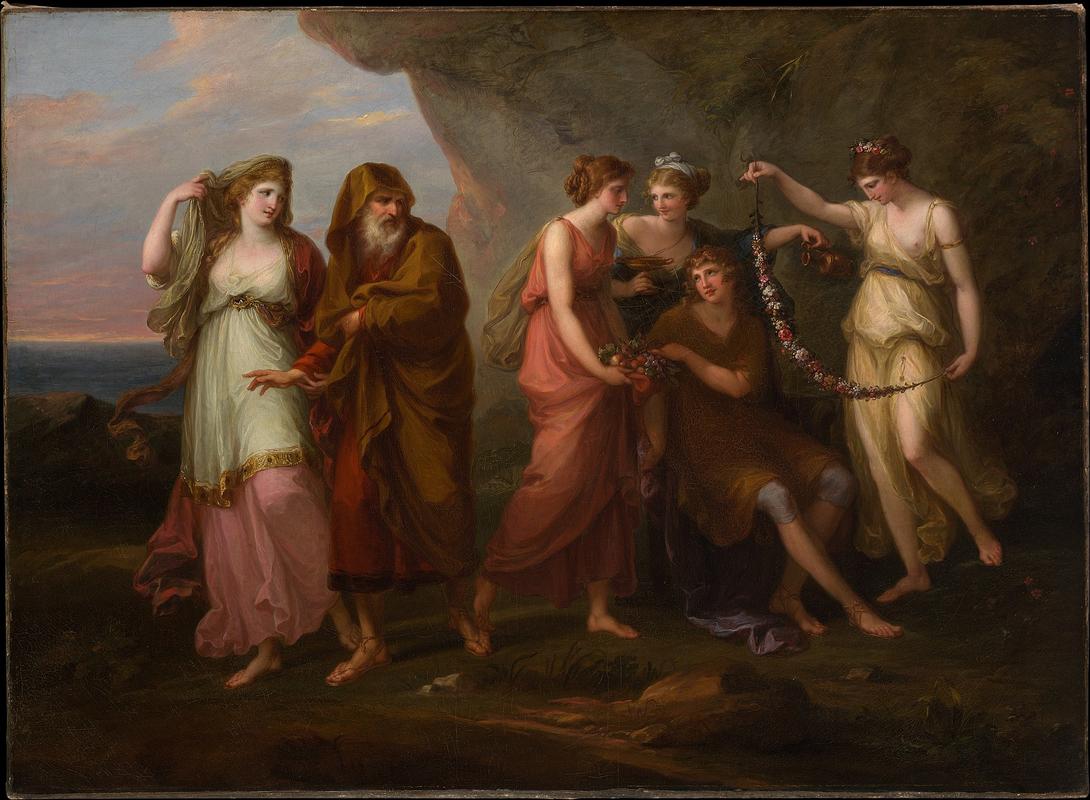More about Telemachus and the Nymphs of Calypso
- All
- Info
- Shop

Contributor
Angelica Kauffmann gives us the heartwarming tale of a young man following in his father's philandering, commitment-phobic footsteps.
The children of famous people very often struggle to get out from under their parents' shadows. Having grown up under constant pressure and in the ever-present glow of the spotlight, the sons and daughters of celebrities will often start acting out in ever-more drastic fashion, hoping to prove that they're just as worthy of attention as mom and dad. That said, the children of the modern era can't hold a candle to the classics, and no matter how far off the deep end Charlie Sheen might go in pursuit of notoriety, even he hasn't hit the point of going to sea and marooning himself on an island full of his dad's ex-girlfriends in an effort to prove himself worthy of the man's legacy.
The same can't be said for the Greek hero Odysseus's son, Telemachus, here depicted by Angelica Kauffmann in her 1782 painting Telemachus and the Nymphs of Calypso. Odysseus, granted, was a pretty tough act for a kid to follow: not only did he mastermind the legendary Trojan Horse, thus winning the Trojan War for his home team the Greeks, but he went on to have so many epic adventures that it took him ten whole years to get home, and the poet Homer had to write a literal epic just to do him some kind of justice. Unfortunately, Odysseus's long absence coupled with his heroic reputation caused Telemachus to develop some pretty epic-caliber daddy issues, and when a couple hundred jerks started harassing his mother Queen Penelope to give up on her long-lost husband and re-marry already, the young fellow climbed aboard a ship and set out to prove he was his father's equal by finding the man and bringing him home at long last.
Homer doesn't go into everything that happened after Telemachus left home, but a later account by the French theologist François Fénelon gives an account of the time Telemachus “just happened” to get wrecked and wash ashore on an island where Odysseus had only recently been cohabiting with the sea-nymph Calypso and her entourage. For whatever reason Telemachus didn't get particularly upset over dear old dad polygamizing his way across the Mediterranean while mom stoically held the fort back home, instead jumping at the chance to learn everything he could about the old man from his most recent, er, “roommates.” The only thing that really got to him was how much he missed Odysseus after hearing all the nymphs' songs and stories about him, and this strengthened his resolve to go and bring him home. So it was that Telemachus wound up proving himself the cat in his father's cradle after all, following in his old man's footsteps by ditching an island full of sea-nymphs to go sailing semi-aimlessly.
Telemachus and the Nymphs of Calypso and its companion piece, The Sorrow of Telemachus, were painted on a commission from the Italian priest Monsignor Onorato Caetani, a model of piety and family values who wished to decorate his wall with the image of a teenager investigating his father's numerous adulteries by drinking with a crowd of semi-nude pagan goddesses. He certainly wasn't alone in his admiration of the subject matter:though nearly a century old at the time of Kauffmann's painting, Fénelon'sLes Aventures de Télémaque (English: The Adventures of Telemachus, in case that was difficult to figure out) remained immensely popular throughout the 1700s, admired by such important thinkers as Jean-Jacques Rousseau and Thomas Jefferson. The characters of Telemachus and Mentor (his teacher—the old man in the painting—from whose name we get the word “mentor,” in case, again, you had trouble with that) enjoyed great popularity as important symbolic figures in the teaching of young men, and Odysseus's whole family would continue to occupy a prominent place in the western consciousness until the year 2004, when the movie Troy was released and ruined everything.
Featured Content
Here is what Wikipedia says about Telemachus and the Nymphs of Calypso
Telemachus and the Nymphs of Calypso is an oil painting by the Swiss artist Angelica Kauffman, from 1782. It is in the collection of the Metropolitan Museum of Art, in New York.
Check out the full Wikipedia article about Telemachus and the Nymphs of Calypso














